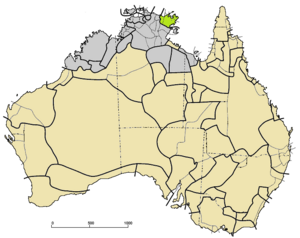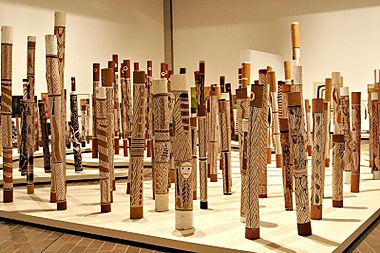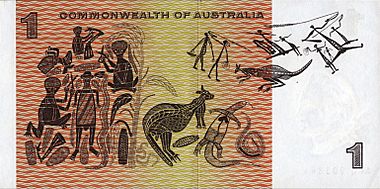Yolŋu facts for kids
 |
|
| Regions with significant populations | |
|---|---|
| Australia | |
| Languages | |
| Yolŋu Matha (Dhaŋu-Djaŋu, Nhaŋu, Dhuwal, Ritharŋu, Djinaŋ, Djinba), Australian English, Yolngu Sign Language | |
| Religion | |
| Traditional religions, Christianity | |
| Related ethnic groups | |
| Australian Aboriginals |
The Yolngu or Yolŋu are a group of Aboriginal Australian people. They live in north-eastern Arnhem Land in the Northern Territory of Australia. The word Yolngu means "person" in the Yolŋu languages. Older names like Murngin were sometimes used by researchers, but "Yolngu" is the correct term.
All Yolngu groups belong to one of two main family divisions called moieties. These are the Dhuwa (or Dua) and the Yirritja moieties. Important Dhuwa groups include the Rirratjiŋu and Gälpu clans. The Gumatj clan is a well-known Yirritja group.
Contents
- What's in a Name?
- Yolngu People and Their Way of Life
- Yolngu Languages
- Understanding the Yolngu Kinship System
- Yolngu Culture, Law, and Stories
- =Ganma - Combining Knowledge
- Yolngu Seasons
- Yolngu History
- Yolngu in Politics
- Yolngu Arts
- Well-Known Yolngu People
- Films About Yolngu
- Garma Festival
- Images for kids
- See also
What's in a Name?
The name "Murngin" was used a lot after a book by an American researcher named W. Lloyd Warner in 1937. His book, A Black Civilization, was seen as a very important study of Aboriginal communities.
However, other experts, like Norman Tindale, thought "Murngin" was not the best name. They felt it was used too broadly for many different groups in north-eastern Australia. The correct spelling was actually Muraŋin, which meant "shovel-nosed spear folk". This name was more fitting for some western groups known for making iron-bladed spears.
Since the 1960s, the term "Yolŋu" has become widely accepted. It is used by linguists, anthropologists, and the Yolŋu people themselves. This term describes both the cultural group and the different languages they speak.
Yolngu People and Their Way of Life
Yolngu people are made up of several distinct groups. These groups speak different languages and dialects. However, they share many similarities in their traditions, ceremonies, and how they live. They have a hunter-gatherer lifestyle in eastern Arnhem Land.
Early researchers tried to classify Yolngu groups using terms like "tribe" or "horde". But today, many experts think these terms don't fully capture the complex way Yolngu society is organized. It's hard to say exactly how many languages or dialects the Yolngu speak. Some studies suggest there could be five, eight, or even eleven different dialect groups.
Yolngu Languages
The Yolngu speak about a dozen languages. These languages are grouped together under the name Yolngu Matha. They also use a Yolngu Sign Language.
Understanding the Yolngu Kinship System
Yolngu groups are connected by a complex family system called gurruṯu. This system is very important. It guides many parts of Yolngu life, including who is responsible for ceremonies and who can marry whom. Children learn about kinship from a young age. They are introduced to people by their family relation, like "grandmother" or "uncle".
Yolngu society is divided into two main family groups, or moieties: Dhuwa and Yirritja. People from each moiety belong to different groups. Each group has its own lands, languages, special animal or plant symbols (totems), and beliefs.
| Moiety | Clan groups |
|---|---|
| Yirritja | Gumatj, Gupapuyŋu, Waŋurri, Ritharrngu, Maŋalili, Munyuku, Maḏarrpa,
Warramiri, Dhalwaŋu, Liyalanmirri, Mäḻarra, Gamalaŋa, Gorryindi. |
| Dhuwa | Rirratjiŋu and Gälpu (both of the Dangu sub-group); Golumala, Marrakulu, Marraŋu, Djapu, Ḏatiwuy,
Ŋaymil, Djarrwark, Djambarrpuyŋu. |
A Yirritja person must always marry a Dhuwa person, and vice versa. Children belong to their father's moiety. So, if a person is Dhuwa, their mother will be Yirritja.
This kinship system also connects to the land. Almost everything is either Yirritja or Dhuwa. This includes fish, stones, rivers, and more. For example, Yirritja yiḏaki (didgeridoos) are shorter and have a higher sound than Dhuwa yiḏaki. A few things are wakinŋu, meaning they don't belong to either moiety.
The term yothu-yindi means child-big (one). It describes the special bond between a person and their mother's moiety. This is the opposite of their own moiety. Because of yothu-yindi, Yirritja people have a special interest in and duty towards Dhuwa people, and vice versa. For example, a Gumatj man can make yiḏaki for his own (Yirritja) group and for his mother's (Dhuwa) group.
The Yolngu word for "selfish" is gurrutumiriw. This literally means "lacking kin" or "acting as if one has no family".
Avoidance Relationships
Like many Aboriginal groups, Yolngu culture has "avoidance relationships". This means certain family members avoid direct contact. The two main avoidance relationships are:
- Son-in-law and mother-in-law
- Brother and sister
Brother-sister avoidance, called mirriri, usually starts after a person's initiation. In these relationships, people do not speak directly or look at each other. They also try to avoid being too close.
Well-Known Yolngu Family Names
- Gurruwiwi – from the Gälpu clan (Dhuwa moiety)
- Marika – from the Rirratjingu clan (Dhuwa moiety)
- Yunupingu – from the Gumatj clan (Yirritja moiety)
Yolngu Culture, Law, and Stories
Yolngu Law
The Yolngu word for "law" is rom. There are special ceremonies connected to Rom. The full system of Yolngu traditional law is called Maḏayin (also written madayan or Mardiyhin). Maḏayin includes the rights of the law's owners, called rom watangu walal. These are the people who have the rights and duties for this law.
Maḏayin includes all the people's law (rom). It also includes the objects that represent the law (Maḏayin girri), spoken rules, names, song cycles, and sacred places (dhuyu ṉuŋgat wäŋa). These places are used to keep, teach, and develop the law. Galarrwuy Yunupingu described Rom watangu as the main law of the land. He said it is "lasting and alive... my backbone". This law covers who owns land and water, and the resources found there. It also controls trade and includes moral, social, and religious law. This includes rules for protecting plants and sea life.
Yolngu believe that living by Maḏayin is the right and civilized way to live. The Maḏayin creates a state of Magaya. This is a state of peace, freedom from fighting, and true justice for everyone.
The story of Barnumbirr (Morning Star) tells about the first death in the Dreamtime. This story marks the beginning of Maḏayin, which is the cycle of life and death.
=Ganma - Combining Knowledge
The Yolngu have a special idea called Ganma. This word describes how two streams of water come together. One stream comes from the land (representing Yolngu knowledge). The other comes from the sea (representing Western knowledge). When they meet, their forces combine. This leads to a deeper understanding and truth. This idea helps explain how Yolngu and Western ways of knowing can work together.
Sacred Objects
Raŋga is the name for sacred objects or symbols used in Yolngu ceremonies.
Yolngu Stories (Mythology)
Wangarr
The idea of Wangarr (also called Wanja or Waŋa) is very important. Wangarr beings are often called "spirit man/woman", "ancestor", or "totem". Yolngu believe that the Wangarr ancestors hunted, gathered food, and held ceremonies, just like Yolngu do today. They also created plants and natural features like rivers, rocks, and islands. These places now hold the spirit of the Wangarr.
The Wangarr also named plants and animals. They made these sacred to certain local groups (clans). Some Wangarr took on the features of an animal or plant, which then became the totem for that clan. Sacred objects and designs are also linked to specific Wangarr. These ancestors also gave each clan their language, laws, paintings, songs, dances, ceremonies, and creation stories.
Wawalag Sisters
The Wawalag sisters are important figures in Yolngu stories. They are two sisters who traveled across the land, creating many features and teaching important laws and ceremonies.
Yolngu Seasons
Yolngu people recognize six different seasons. These are Miḏawarr, Dharratharramirri, Rärranhdharr, Bärra'mirri, Dhuluḏur, Mayaltha and Guṉmul. Each season has its own weather patterns and affects how people live and gather food.
Yolngu History
Contact with Macassans
For at least 200 years before Europeans arrived, the Yolngu traded a lot with Macassan fishermen. These fishermen came yearly from what is now Indonesia. They came to collect trepang (a type of sea animal) and pearls. They paid the Yolngu with things like knives, metal, canoes, tobacco, and pipes. In 1906, the South Australian Government stopped the Macassans from coming. This caused economic problems for the Yolngu.
Yolngu oral histories also speak of a people called the Baijini. Some believe these were other visitors to Australia before the Macassans. Others think they might be a memory of Yolngu people who traveled to Indonesia and came back.
Yolngu also had strong trade routes within Australia. They traded with groups in Central Australia and other Aboriginal lands. For example, they didn't make boomerangs themselves. Instead, they got them through trade from Central Australia. They used message sticks and "mailmen" to send messages and orders between groups. Some men walked hundreds of kilometers for this work.
Contact with Europeans
Yolngu knew about Europeans before the British arrived in Australia. This was through their contact with Macassan traders. Their word for European, Balanda, comes from a Malay word for "Dutch person".
Nineteenth Century European Contact
In 1883, David Lindsay was the first white explorer to enter Yolngu lands. He was surveying the area for resources. In 1884, a large area of Arnhem Land was sold to a cattle farmer named John Arthur Macartney. This property was called Florida Station. The people who managed the station sometimes used violence against the local Aboriginal people. This led to many Yolngu deaths. However, the strong resistance from the Yolngu stopped further attempts by balanda (Europeans) to take over their land. Also, floods and disease caused Florida Station to be abandoned in 1893.
Twentieth Century European Contact
In the early 1900s, Yolngu stories tell of groups of armed men entering their lands. From 1903 to 1908, a large company tried to start a cattle and meat business in Arnhem Land. This company used armed men to shoot the Aboriginal people living there.
The first mission was set up on Milingimbi Island in 1922. This island is the traditional home of the Yan-nhaŋu people.
From 1935 to 1937, a researcher named Donald Thomson lived with the Yolngu. He took photos and wrote about their way of life. These records are now very important for both Yolngu and European Australians. In 1935, a Christian mission opened at Yirrkala.
During World War II (1941), Thomson convinced the Australian Army to create a special unit of Yolngu men. This unit helped protect Australia's northern coast from Japanese raids. Yolngu men met Australian and US soldiers. Thomson tried to stop soldiers from taking Yolngu spears as souvenirs. These spears were vital for Yolngu life and took days to make.
More recently, large mines have been built on Yolngu lands at Nhulunbuy.
Yolngu in Politics
Since the 1960s, Yolngu leaders have been very active in fighting for Aboriginal land rights.
In 1963, the government decided to take part of their land for a mine. Because of this, the Yolngu people at Yirrkala sent a petition written on bark to the Australian Parliament. This bark petition gained national and international attention. It is now displayed in Parliament House, Canberra. It shows the important role Yolngu played in starting the land rights movement.
When politicians didn't change their minds, the Yolngu of Yirrkala took their concerns to court in 1971. This was known as the Gove land rights case. The Yolngu lost the case because Australian courts still followed the idea of terra nullius. This meant they didn't recognize any prior land rights for Indigenous people at the time of colonization. However, the judge did agree that the Yolngu used the land for their traditions and economy. He also agreed they had an established system of law. This helped pave the way for future recognition of Aboriginal land rights. It played a vital part in the Aboriginal Land Rights Act 1976 and the Mabo decision in 1992.
The song "Treaty" by the band Yothu Yindi became a global hit in 1989. It was a protest about the government being slow to act on promises about Aboriginal land rights. The song strongly asked for respect for Yolngu culture, land, and law.
Yolngu Arts

Yolngu artists and performers have helped bring Aboriginal and Torres Strait Islander culture to the world. Yolngu traditional dancers and musicians have performed globally. They have also influenced modern dance groups like Bangarra Dance Theatre.
Yolngu Visual Art
Before the Western Desert art movement, Yolngu paintings on bark were the most famous Aboriginal art. These paintings often use fine cross-hatching. The hollow logs (larrakitj) used in Arnhem Land burial practices are very spiritual. They are also important surfaces for Yolngu art. A bark painting by David Malangi Daymirringu was copied and put on the original Australian one-dollar note. When this was discovered, the Australian government paid the artist for his work.
Yolngu people are also skilled weavers. They weave dyed pandanus leaves into baskets. They also make necklaces from seeds, fish bones, or shells. Colors are often important in Yolngu artwork. They can show where the art comes from and which family group created it. Some designs are unique to specific families and clans.
Yolngu Music
The band Yothu Yindi became Australia's most successful modern Indigenous music group. Their song "Treaty" was a global hit. They have performed all over the world.
Arnhem Land is the home of the yiḏaki, which Europeans call the didgeridoo. Yolngu people play and make yiḏaki. Only certain men can play it, and there are strict traditional rules about its use.
Dr G. Yunupingu (1971–2017) was a very famous Yolngu singer.
Well-Known Yolngu People
- Baker Boy (Danzal Baker)
- Laurie Baymarrwangga
- George Rrurrambu Burarrwanga
- Gary Dhurrkay
- Gatjil Djerrkura
- Nathan Djerrkura
- David Gulpilil
- Djalu Gurruwiwi
- Leila Gurruwiwi
- Rarriwuy Hick
- David Malangi
- Banduk Marika
- Raymattja Marika
- Roy Marika
- Wandjuk Marika
- Janet Munyarryun
- Galarrwuy Yunupingu
- Geoffrey Gurrumul Yunupingu
- Mandawuy Yunupingu
Politicians
- Yingiya Mark Guyula, an Independent member for Nhulunbuy in the Northern Territory Legislative Assembly.
Films About Yolngu
- Ten Canoes
- Westwind: Djalu’s Legacy, about Djalu Gurruwiwi
- Yolngu Boy
- High Ground
Garma Festival
Every year, Yolngu people gather to celebrate their culture at the Garma Festival of Traditional Cultures. People who are not Yolngu are welcome to attend the festival. They can learn about Yolngu traditions and law. The Yothu Yindi Foundation helps organize this festival.
Images for kids
See also
 In Spanish: Yolngu para niños
In Spanish: Yolngu para niños
- Gove land rights case
- Indigenous Australian food groups
- Yirrkala bark petitions
- Taboo against naming the dead
- Australian Aboriginal astronomy



